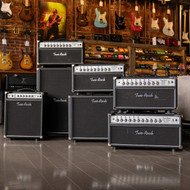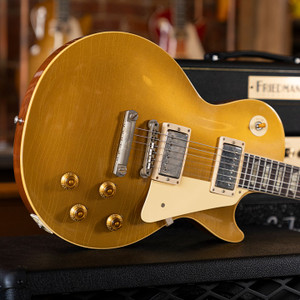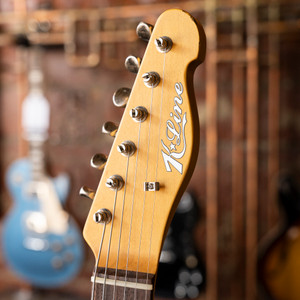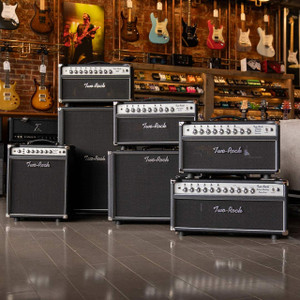Tube Amp vs. Modeling Amp: Why Tube Amps Still Kick Ass
May 30th 2025
Alright, let’s get into it — tube amps vs. modeling amps. It’s a debate as old as…digital delay? If you’ve ever played through both, you already know: modeling amps have come a long way, but tube amps? In our humble opinion, they’re still the boss. There’s just something about that rich, lively, 3D tone that no amount of code can truly capture.
Let’s break it down, swap a few stories, and see why we think tube amps still wear the crown.
The Tale of Two Gigs
Picture this. It’s a Friday night, you’re playing at your local dive bar. Your buddy rolls up with a fancy new modeling amp, something that looks like it came out of a spaceship, loaded with every amp sim and effect known to man. You, on the other hand, brought your trusty tube combo and your go-to pedalboard. Maybe a Deluxe Reverb or a Mesa/Boogie amp. Nothing fancy. Just honest-to-goodness glass and metal.
Your friend plugs in, scrolls through 40 presets, trying to find the "right tone." The PA is terrible, so you can barely hear their guitar, and what you do hear is shrill and bright. You plug in, hit an open chord, and the whole room leans in. Your amp isn’t modeling a sound — it is the sound, straight to the ears of the audience.
That’s the magic.
The Real Deal Feel
Here’s the thing: tube amps breathe. They respond to your touch. Play softly, they stay clean. Dig in, and they bark, growl, and sometimes even sing. That natural compression and sag from the tubes doing their thing? You can literally feel it.
Modeling amps try to replicate this with algorithms, but let’s be real — they’re still just mimicking. It’s like drinking instant coffee and calling it a pour-over. They’re actually getting really close nowadays, but it’s that final 10-20% that is still just not quite right.
If you’ve ever ridden the volume knob on your guitar just right to clean up a crunchy tone on a tube amp, you know what we mean. That kind of interaction is like a secret handshake between player and amp.
Let’s Talk Tech — Briefly, We Promise
Okay, here’s a little nerdy break (we’ll keep it light):
- Tube amps use vacuum tubes to amplify your signal. They’re analog, which means the signal path stays pure, raw, and uncompressed — until the tubes themselves start to break up. That’s the sweet spot.
- Modeling amps use digital processors to simulate different amp sounds and effects. They're often lightweight, versatile, and consistent, which is cool for practice or studio work. They instantly convert your pickup's magnetic signal into 1s and 0s.
But here’s the rub: digital signals can feel flat. Predictable. Tube amps are like a vintage muscle car — loud, imperfect, and full of character. Modeling amps are more like Teslas: quiet, efficient, and they beep at you a lot and flash bright lights in your face.
Hybrid Rigs: The Best of Both Worlds?
Now, for the middle grounders out there, let’s talk hybrid setups.
Some folks have figured out how to ride the line between classic tone and modern convenience. Maybe you’re running your favorite analog pedalboard into a high-end modeler like a Kemper, Helix, or Quad Cortex. Or maybe you're going the other way: dialing up a killer modeler preset and running it straight into the front of a clean tube amp.
Guess what? That works.
In fact, it's kind of awesome. You get the flexibility of digital impulse responses, instant recall of presets, tons of tonal options, while still leaning on the warmth, punch, and feel of analog gear. It’s not “cheating.” It’s smart.
It’s a way to embrace technology without giving up the stuff that makes playing guitar so damn fun. No gatekeeping here. If it sounds good and feels right, you’re doing it right.
Why Guitarists Still Chase Tubes
There’s a reason the floors at Midwood Guitar Studio are lined with all kinds of guitar amps for sale, but the real eye-catchers are the tube rigs. Players walk in, plug into a Two-Rock, a Friedman, or a handwired Vox AC30, and suddenly they’re playing — not tweaking menus or scrolling presets.
Tube amps make you feel something. You don’t just hear them — you interact with them.
You can’t model mojo.
But Aren’t Tube Amps a Pain?
We hear this one a lot. “Tube amps are heavy. They need maintenance. What if a tube blows mid-set?”
Sure, there’s a little upkeep involved. And yeah, that Vox AC30 might feel like you’re hauling an anvil. But that tone? That glorious, harmonically rich, touch-sensitive tone? Worth it.
Some players go hybrid — modelers for convenience, tube heads for shows. That’s cool. But if you’re chasing that sound — the one that made you fall in love with the guitar in the first place — you’re gonna end up back at a tube amp.
We’ve all been there.
Try It Yourself (Seriously)
If you’re curious, swing by the guitar shop. We've got a showroom full of guitar amps for sale, and the best way to decide is to plug in and play. Crank up a tube amp and let your guitar rip through a real-deal, handwired circuit and a set of tubes. Then try a modeler. You'll feel the difference.
It’s not about being a tone snob. It’s about finding the sound that feels like you.
Final Word: Tubes Just Kick Ass
Look, we’re not here to diss modeling amps. They have their place, and we use them from time to time. But when it comes to raw tone, emotional response, and straight-up character, tube amps still run the show.
They’ve been doing it for 70+ years, and they’re not going anywhere.
So if you're hunting for inspiration — or just an incredible amp — come check out the tube amps we’ve got at Midwood Guitar Studio. Because when your tone is right, everything else just falls into place.






